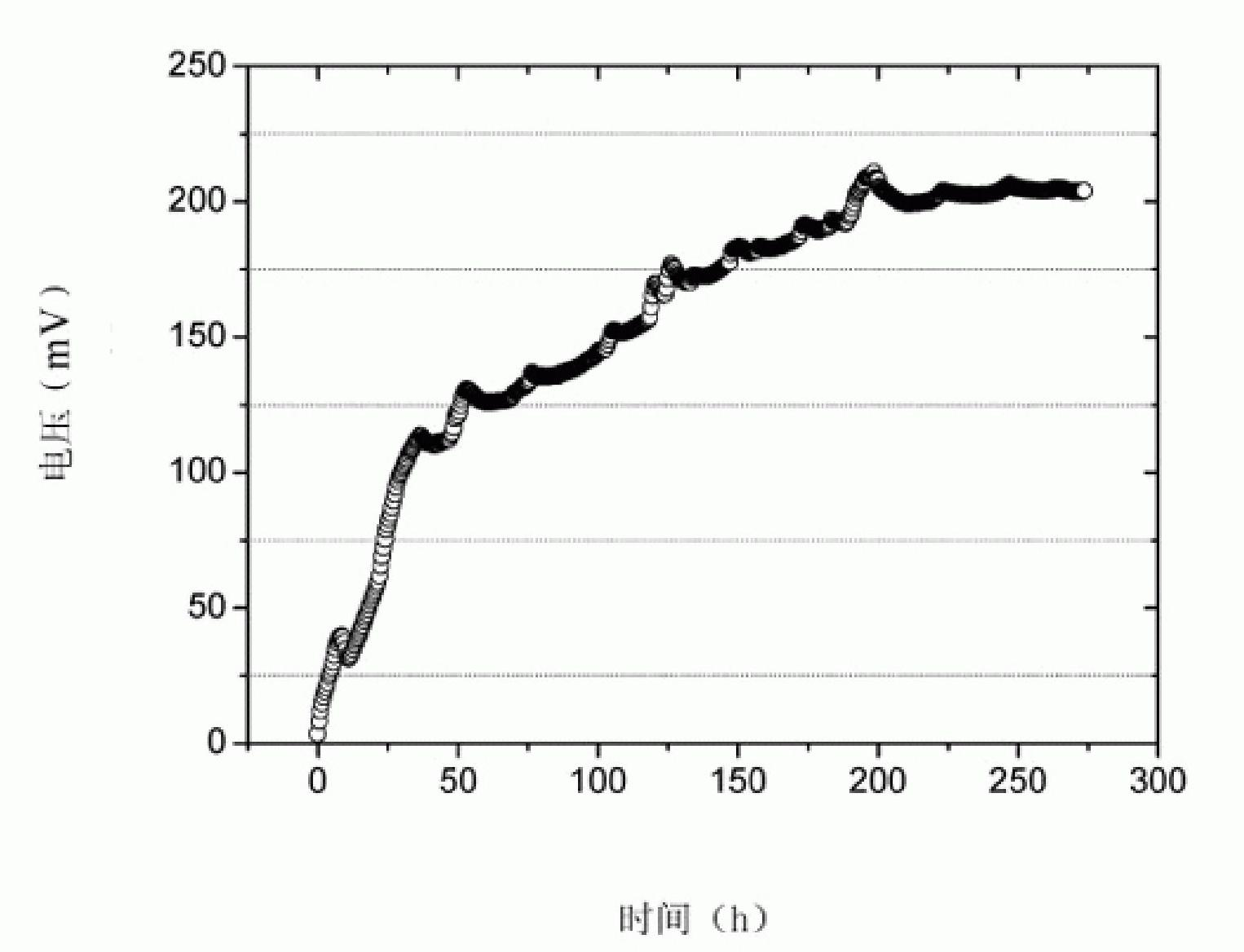Shewanella spp and application thereof in microbial fuel cell
A Shewanella and fuel cell technology, applied in the biological field, can solve problems such as reports of unseen systems, and achieve the effects of broad industrial application potential, high electrical activity, and high electrical activity.
- Summary
- Abstract
- Description
- Claims
- Application Information
AI Technical Summary
Problems solved by technology
Method used
Image
Examples
Embodiment 1
[0041] Embodiment 1: Screening of S4 bacterial strain
[0042] Marine sediment samples were collected from the bay near Xiamen, China. Take 2 grams of sediment samples and suspend them in 250 milliliters of microbial fuel cell anolyte solution for enrichment culture. The composition of the anolyte medium (RM) is: 1000 ml deionized water, 19.0g NaCl, 4.9g MgCl 2 , 1.30 g K 2 HPO 4 , 0.45g KH 2 PO 4 , 0.19g (NH 4 ) 2 SO 4 , 0.25gMgSO 4 , 10ml Wolfe’s Minerals, 0.05g CaCl 2 , 0.02g L-arginine, 0.02g glutamic acid, 0.02g serine and 0.10g yeast powder, wherein 10mmol / L of sodium lactate (DL-lactate) was added as an electron donor. The composition of the battery catholyte is the same as that of the anolyte except that amino acids and yeast powder are not added, and the corresponding sodium chloride needs to be added to the catholyte to balance the osmotic pressure between the catholyte and the anolyte. The microbial fuel cell device adopts H-shaped structure ( figure 1 )...
Embodiment 2
[0043] Example 2: Acquisition and induction of S4 electrogenic seeded cells
[0044] Pick the S4 strain colony cultured on the LB plate, inoculate it into 20 ml of RM medium, add 20mmol / L sodium lactate as electron donor and carbon source, cultivate at 30°C for 12 hours at 180 rpm, and then press 0.1% The inoculum amount was added to 100 ml of anaerobic RM medium, in which 20 mmol / L sodium lactate and 20 mmol / L sodium fumarate were added as electron donor and electron acceptor, respectively, and cultured at 30°C for 12 hours, then Inoculate 0.1% into anaerobic RM medium with 50mmol / L ferric citrate and 20mmol / L sodium lactate as electron acceptor and donor, 30? After culturing for 12 hours, the bacterial cells were obtained by centrifugation under anaerobic environment. Place the cells in 100 ml of anaerobic RM medium, mix and shake for 1 to 2 hours, and centrifuge to obtain the cells again.
Embodiment 3
[0045] Example 3: Electricity production using resting cells of the S4 strain
[0046] According to the cultivation and inoculation method described in Example 3, the cells in the late logarithmic period of growth were obtained from 1000ml of ferric citrate and sodium lactate as the anaerobic RM medium of the electron acceptor and donor, and were centrifuged under anaerobic conditions. 100ml of anaerobic phosphate buffer (50mM sodium phosphate buffer, pH=7.0) was resuspended and centrifuged to wash the cells twice, and finally resuspended in 5ml of anaerobic phosphate buffer, which was used as an inoculum and inoculated to anode in a microbial fuel cell. Both the anolyte and catholyte of the microbial fuel cell use 50mM sodium phosphate buffer solution (pH=7.0), the anode is fed with high-purity nitrogen to ensure an anaerobic environment, and the cathode is fed with air to make oxygen as the final electron acceptor. See Example 1 for other settings and conditions of battery ...
PUM
| Property | Measurement | Unit |
|---|---|---|
| diameter | aaaaa | aaaaa |
| length | aaaaa | aaaaa |
Abstract
Description
Claims
Application Information
 Login to View More
Login to View More - R&D Engineer
- R&D Manager
- IP Professional
- Industry Leading Data Capabilities
- Powerful AI technology
- Patent DNA Extraction
Browse by: Latest US Patents, China's latest patents, Technical Efficacy Thesaurus, Application Domain, Technology Topic, Popular Technical Reports.
© 2024 PatSnap. All rights reserved.Legal|Privacy policy|Modern Slavery Act Transparency Statement|Sitemap|About US| Contact US: help@patsnap.com










